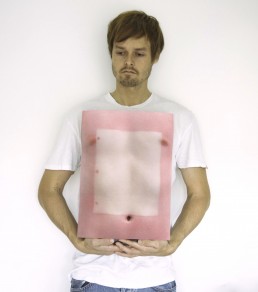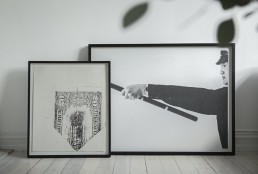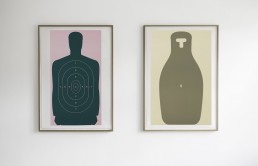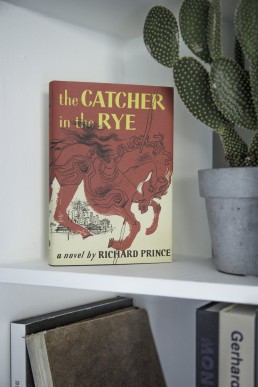“Just start. If you wait for that perfect piece, you will postpone it forever, and then you die”
Interview: Art Collector Eirik Stensrud
One might describe Eirik Stensrud’s approach to art collecting as ‘gallows-humoristic’, others as a matter of fact. In either case, he isn’t the type who waits for that one perfect piece. Surely, he misses a work by Wurm, but that doesn’t prevent him from expanding his art collection. Or as he describes himself, “a guy that enjoys art and buys it from time to time.” Nonetheless, the Norwegian guy has a clear idea of what kind of art he would like to include in his life: something that hits hard, knocks him down, and leaves him feeling enriched such as that pair of stiff (resin) tennis socks standing in a window frame that makes him laugh every time he looks at them. Mark his words: “Just start”… you might end up with a pair of socks lighting up your life!

Name: Eirik Stensrud
Location: Oslo
Started collecting in year: 2010
Number of artworks in collection: About 40
What is your earliest memory of art, and what led you to start collecting it?
As a kid, my mother would always drag me into museums looking at modern masters such as Chagall, Matisse, and Picasso. I found it pretty boring. When I was around 11, we visited the Pompidou Center in Paris. In the exhibit, there was a video of a man ripping hair from his belly, stripping it clean. It was something completely different from any art I had seen before. That piece really made an impact. I believe the artist was Vito Acconci. Around 2001, I went to an exhibition opening in Bali. I was introduced to the artist and thought that it would be polite to compliment the work. ”Ah! So you like the work Erik?”. From then on, I was politely pushed into buying two paintings.

How would you describe yourself as an art collector?
I actually will not call myself a collector, I am more of a guy that enjoys art and buys it from time to time. Lately I have been reading this book (Please Pay Attention Please) with Bruce Nauman interviews. This passage is a good description of the kind of art I am hoping to find:
“Art that is there all at once. Like getting hit in the face with a baseball bat. Or better, like getting hit in the back of the neck. You never see it coming: it just knocks you down. A kind of intensity that doesn’t give you any trace of whether you’re going to like it or not.”
What is the main motivation behind your collecting?
Mark Titchner has a work called “Build The World That You Want To Belong In”. I guess he used the sentence semi ironic, but I think it has some truth to it that can be related to collecting art. It is about surrounding yourself with objects and ideas that make your life richer. For example, I have a pair of stiff (resin) tennis socks standing in a window frame and it makes me laugh (internally) every time I look at them.
Describe your collection in three words.
Missing a Wurm.
Is there any particular type of art that appeals to you or anything that unites all the works in your collection?
I do not know how it happened, but the colour pink is present in almost half my collection.
How important is it for you to meet the artist behind the artwork?
I find studio visits somewhat awkward.
What is the most recent piece of art you added to your collection and why?
Killer Crocodile, a painting on paper by B. Thom Stevenson, a young artist from NY. I have some works by him already, and when Exhibition A released a series of affordable works, it made sense to buy it.
Has digitalization changed the way you collect art?
Sure. Having the art world (literally) at our fingertips is great for discovering new artists or get a glimpse of works in progress. One drawback is that the overload of impressions can lead to more surface-level browsing rather than digging deeper into a specific work. In the future, I hope more artists will use social media as a part of their artistic practice, the early Instagram feed of Richard Prince was pretty entertaining to watch.
What or who has influenced you as a collector?
In high school, I was really into figurative art idolizing Odd Nerdrum. I remember our teacher (an artist called Øivind Brune) gave us an assignment to create a painting consisting of three different materials. That simple task was actually a bit of a turning point and opened my eyes to abstract and conceptual art.
Is there any specific place you always return to when you need an art fix?
Astrup Fearnley has an impressive collection and is always a safe bet. In the last couple of years, Oslo has also seen a growth of independent galleries with international quality.

The art market has a reputation of being a playground for the elite. What is your experience of this?
There is still some snobbery lurking around. Like one unnamed Oslo gallery that ‘only’ sells to people they see fit. I do not like it, but from a branding perspective, it is pretty smart. Maybe it was a result of Pamela Anderson buying a piece by Gardar Eide Einarsson?
Where do you think the future of the art market is headed?
I cannot say for sure, but the growing mass of Chinese collectors will probably lead to a shortage of artworks in the market. Artists will use big data to produce work that caters to whatever the market is hungry for. Robots will be used to produce, buy and sell trending works. At one point, the robots will be so advanced that they develop human emotions and will soon use their supreme intelligence to benefit themselves, not the humans. Then they will send a cyborg from the future to kill Larry Gagosian’s mother.

Top three pieces of advice for new collectors
1. Just start. If you wait for that perfect piece, you will postpone it forever, and then you die.
2. Buy something a little more expensive than you can afford. You will suffer for a while, but you will appreciate the work more.
3. Be careful with street art. It is a bit like a tribal tattoo: It looks cool at first, but after a while, you just want to hide it.
Top three art destinations
1. Standard, Golsa, Schloss, Oslo
2. The Hole, NYC
3. V1, Copenhagen
Three inspiring artists to watch
1. Adam Parker Smith
2. Timur Si-Qin
3. Yngve Holen
Get your free copy of Artland Magazine
More than 60 pages interviews with insightful collectors.

